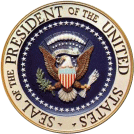|
ZACHARY TAYLOR |
|

THE 12TH PRESIDENT OF
THE UNITED STATES OF AMERICA
(1849-1850)
TAYLOR, Zachary
(1784–1850), U.S. general in the Mexican War, who became the 12th president of the U.S. (1849–50).Taylor was born on Nov. 24, 1784, in Orange Co., Va., the son of a veteran of the American Revolution. Taken to Kentucky as a child, he grew up on his father’s plantation near Louisville, where he was educated by local tutors. He was married (1810) to Margaret Mackall Smith (1787–1852) of Maryland, with whom he had four children; one of these was the first wife of Jefferson Davis, later Confederate president; another became a Confederate general.
Military Career.
In 1808 Taylor joined the regular army as an infantry officer. After distinguishing himself under William Henry Harrison in the War of 1812 and briefly returning to civilian life, he saw active duty on various frontier posts in the Northwest and Louisiana, where he established a second home. He participated in the Black Hawk and Second Seminole wars and in 1838 defeated the Seminole in the Battle of Lake Okeechobee. Although not decisive, this engagement earned him promotion to the rank of brigadier general, and he was given overall command of the campaign against the Seminole in Florida.
In the early 1840s Taylor was stationed at the southwestern boundaries of the U.S. Sent to Texas shortly before the outbreak of war with Mexico, he was ordered to advance into the disputed territory between the Nueces River and the Rio Grande, where he defeated Mexican detachments at Palo Alto and Resaca de la Palma (May 8–9, 1846). These battles made him famous and led to the U.S. declaration of war on Mexico. Taylor, now a major general, subsequently captured Matamoros and Monterrey. Part of his command was detached to join Gen. Winfield Scott in central Mexico. Nevertheless, on Feb. 22–23, 1847, Taylor routed a numerically superior force assembled under Mexican president Antonio López de Santa Anna at Buena Vista, a feat that thrilled the nation.
Political Career.
Taylor, who had never bothered to vote, had little political experience, but he had quarreled with President James K. Polk and sympathized with the Whigs, and thus seemed a perfect candidate for the opposition. Although he declared himself nonpartisan and was a slave owner, which might have made him unpopular in the North, the Whig party nominated him for the presidency in 1848. In the ensuing election, he defeated both his Democratic and Free-Soil opponents.
The Taylor administration encountered severe difficulties. To end British encroachments in Central America, it concluded the Clayton-Bulwer Treaty (1850) neutralizing any future Atlantic-Pacific canal in that area, an arrangement that proved unpopular in the U.S. Taylor favored granting immediate statehood to California and New Mexico, which had been acquired as a result of the war, but when California prohibited slavery, the South opposed its admission to the Union. The president, however, refused to reconsider. Adamantly resisting Henry Clay’s compromise proposals, which sought to balance southern with northern concessions, he declared himself ready to use force to prevent secession or a threatened seizure of eastern New Mexico by Texas. His stand completely alienated southern Whigs, and it contributed to an impasse in the U.S. Congress. In the midst of this controversy Taylor fell ill, and he died on July 9, 1850. His death removed the principal obstacle to the ultimate passage of the Compromise Measures of 1850.
Taylor was an adequate but by no means brilliant general, who reached the presidency without preparation at a critical moment. Whether, as has been suggested, a continuation of his hard-line policy toward the South might have prevented the American Civil War will never be known.





